John E. Idiake 1, Abdullateef A. Shittu 1, Anthony I. Anunobi 2, William P. Akanmu 3
1Department of Quantity Surveying, Federal University of Technology, Minna, Nigeria
2Department of Architecture, Federal University of Technology, Minna, Nigeria
3Department of Building, Federal University of Technology, Minna, Nigeria
Correspondence to: John E. Idiake , Department of Quantity Surveying, Federal University of Technology, Minna, Nigeria.
| Email: |  |
Copyright © 2015 Scientific & Academic Publishing. All Rights Reserved.
Abstract
Research has revealed that projects surveyed in Nigeria suffered delays in project performance as a result of defects in the contract documents. The emphasis on procurement methods is on optimizing all parameters involved in project delivery namely, time, cost and quality but sadly in Nigeria, procurement of projects within these constraints has continued to be a challenge to the design team, the contractors, and managers of investments. Data were collected from selected building contractors in Abuja on 50 public building projects with the use of questionnaires and secondary/archival data were collected and tabulated for easy analysis. The factors affecting the performance of procurement methods were also assessed under which the complexity of design, capital cost of project and adequacy of contractor resources were identified as the most important factors affecting the performance of traditional procurement method. For the design & build procurement method the most important factors identified were financial risk, alterations to design and involvement of non contractual parties. It was also discovered that project completion at estimated cost, project completion at estimated time are the most important criteria for selection of traditional procurement method while in the design & build method, project completion at estimated time, project completion at estimated cost, nature of project and quality assurance were the major selection criteria. In terms of project performance, design & build procurement method was discovered to perform better in terms of cost and time than the traditional method implying that projects under the design & build procurement method are usually completed within the estimated contract sum and duration and lower level of cost and time overruns are conceded. In view of these findings, major recommendations of the study are that qualified professionals should be employed in the various construction processes to reduce the risk of time and cost overruns in the execution of projects and that clients adopting Design & Build procurement method should ensure that a well detailed and exhaustive brief is given to the contractor before the commencement of the project.
Keywords:
Construction industry, Design & build, Procurement method, Selection criteria, Traditional
Cite this paper: John E. Idiake , Abdullateef A. Shittu , Anthony I. Anunobi , William P. Akanmu , A Comparative Analysis of Traditional and Design & Build Methods of Procurement in the Nigerian Construction Industry, International Journal of Construction Engineering and Management , Vol. 4 No. 1, 2015, pp. 1-12. doi: 10.5923/j.ijcem.20150401.01.
1. Introduction
1.1. Background to the Study
Procurement comes from the word “procure” which literally means “to obtain by care or effort”; “to bring about” and “to acquire”. Procurement system is about “organised method, approach, technique, process or procedure” (Ogunsanmi, lyagba and Omirin, 2003). In this context, project procurement is very much concerned with the organised methods or process and procedure of actualizing a construction product. Procurement process is the entire procurement cycle starting from the identification of need, through to the completion of the contract. This process includes the ‘Traditional method’ which is also known as ‘Design-Bid-Build method’, the most widely used in Nigeria. The other methods are put into one group called the ‘Non-Conventional Methods’ of procurement which include the Design and Build, Project Management, Construction management, Management Contracting, Labour-Only, Direct-Labour, and other discretionary procurements such as Alliancing, Partnering, and Joint Ventures. Studies confirming the use of these procurement methods in Nigeria include Ogunsanmi, et al (2003), Ibiyemi, Adenuga and Odusami (2005), Ojo, Adeyemi and Fagbenle (2006), Babatude, Opawole and Ujaddighe (2010) and Dada (2012). This study focuses on the main procurement methods used in Nigeria which are the Traditional procurement method and the Design-Build procurement method. Against the above background, there is therefore, the need to investigate the processes involved in obtaining contract awards and execution processes through to the completion.The main aim of every client at the beginning of a project is to ensure that a quality structure is achieved at the end of the project. Researchers, Babatunde et.al (2010) asserted that this aim is not met in most cases. Despite the fact that the construction industry in Nigeria is a vital contributor to the process of development, the industry is still characterized by under-performance when compared with other industries.Research has revealed that projects surveyed in Nigeria suffered delays in project performance as a result of defects in the contract documents. The emphasis on procurement methods is on optimizing all parameters involved in project delivery namely, time, cost and quality but sadly in Nigeria, procurement of projects within these constraints has continued to be a challenge to the design team, the contractors, and managers of investments. Part of the problem stems from lack of current information on how the design-build method of procurement performs in terms of time and cost in relation to the performance of the traditional procurement routes. Against this background, there is therefore the need to know the levels of cost and time compliance of the two project procurement methods and to investigate the performance of projects under the two procurement methods. This is the focus of this study.
2. Methodology and Data Collection
This study employed the qualitative and quantitative research approaches and data collection was gathered from both primary and secondary sources. Questionnaires were designed and distributed to professionals in the construction industry to respond to the issues raised in the questionnaires. The data gathered in this regard forms the primary source of data while a wide range of review of literature from journal articles, internet surfing and other published books were used to collect data from the secondary source. The questionnaires were administered to various categories of respondents within the target population. The responses of respondents form a great part of the research. Also primary sources of data were collected through the quantitative approach. Cost and time data of projects under review for the traditional and design-build methods were obtained from documented records of past projects procured. Research data were collected from the primary sources with the use of questionnaires in order to identify the criteria for the selection of procurement methods prior to contract award and to identify the factors affecting the performance of procurement methods in Nigeria. The data collected from the secondary sources were information gathered from literature review which assisted the study to build up a theoretical framework and to identify the criteria for the selection of procurement methods prior to contract award and the factors affecting the performance of procurement methods in Nigeria. Information gathered from the contract documents of the selected contractors on the executed contracts for 2012 with the same project characteristics using the Traditional and Design & Build Procurement Methods also constituted the data obtained from the secondary source. The data gathered here were on the estimated and actual cost and duration of the selected projects for the Traditional and Design & Build Procurement Methods which was used to establish percentage cost and time overruns respectively and these were further used to compare the cost/time performance between the traditional and the design and build methods.The target population for this study included Architects, Quantity Surveyors, and Builders. This was because the key performance of any procurement method in terms of cost, quality and time depends on the expertise and experience of these professionals from inception to completion. The survey was open to consulting, contracting and public organisations accordingly. The sampling frame for this study included the list of the Professionals (Architects, Quantity Surveyors, and Builders) working in consulting, contracting and client firms as compiled by their respective professional institutes from which samples were drawn. The population for the study was 72 which comprise contractors fully registered with the Federation of Construction Industry (FOCI), Nigeria. Based on this, 72 questionnaires were sent out to these contractors out of which 50 were returned. Information used from the secondary data was collected from the contract documents of the 50 contractors who responded to the questionnaires and a project was selected from each contractor with similar project characteristics. This gives a total of 50 projects used for the study and these were presented in Section 3. A total of 72 questionnaires were administered to construction professionals using random sampling technique; out of which 50 questionnaires were retrieved which were found suitable for analysis. This represents about 69% response rate, which is far above the typical norm of 20 – 30% response rate in questionnaire survey. The questionnaire sample is presented in the Appendix section of this paper.The collected data for this research were presented using tables and bar charts. The criteria for selection of procurement methods and the factors affecting the performance of procurement methods under examination were analyzed using the mean item score with the aid of SPSS 15.0 and presented in tables. Percentage cost overrun was computed from the collected data using the Microsoft Excel Software. The use of independent sample T-Test was employed to determine the statistical difference existing in cost and time overrun respectively between the traditional procurement method and the design and build procurement method. The T-Test was used to test the postulated hypothesis at 95% confidence interval using the decision rules.
3. Data Presentation, Analysis and Discussion of Results
3.1. Results and Discussion of Analysis from Primary Data
3.1.1. Criteria for Selection of Procurement Methods
The Tables 3.1 and 3.2 below show the results of the identified selection criteria for the traditional and design and build procurement methods respectively ranked in order of importance.Table 3.1. Traditional Procurement Method Selection Criteria
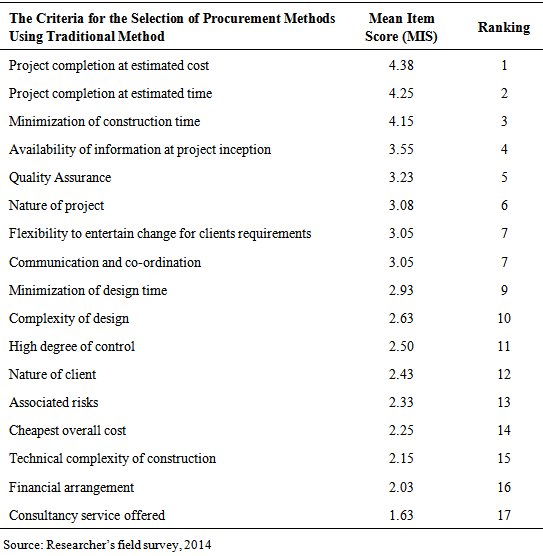 |
| |
|
Table 3.2. Design & Build Procurement Method Selection Criteria
 |
| |
|
It is observed from Table 3.1 that out of these criteria for the selection of project execution using traditional procurement method, project completion at estimated cost ranked 1st with mean item score of 4.38, followed by project completion at estimated time with mean item score of 4.25, minimization of construction time with mean item score of 4.15 and availability of information at project inception with mean item score of 3.55. The table also reveals that the least used criteria are technical complexity of construction, financial arrangement and consultancy services offered with mean item scores 2.15, 2.03 and 1.63 respectively in descending order. This result can be justified since the factors most considered in the selection of traditional procurement are the possibility of having no cost overruns which ranked 1st and time overruns. Also, the availability of information at the inception of a project was a factor considered owing to the fact that planning and design stages are done by the client, the information about the process is readily available to both parties since the contractor executes the construction of the project.It is observed from the Table 3.2 that out of these criteria for the selection of projects under design & build procurement method, the project completion at estimated time ranked 1st with a mean item score of 4.50, followed by project completion at estimated cost, nature of project and quality assurance ranking 2nd, 3rd and 4th respectively with mean item scores of 4.25, 4.15 and 4.08 respectively. The table also reveals that the least used criteria are cheapest overall cost, financial arrangement, and consultancy services offered with mean item scores 2.25, 2.03 and 1.63 respectively. This can be justified as design & build method is more appropriate for clients that want to reduce the risk of time and cost overruns. The design & build method involves lesser time to execute in the planning and design stage since all is being taken care of by the contractor including the bulk of the funding. Also, the desired quality can be achieved within the estimated time and cost which is the client’s priority.
3.1.2. Factors Affecting the Performance of Procurement Methods
The results of the Mean Item Scores used to rank the identified factors affecting the performance of both the traditional and the design & build procurement methods in order of importance are presented in Tables 3.3 and 3.4 below.Table 3.3. Factors Affecting the Performance of Traditional procurement Method
 |
| |
|
Table 3.4. Factors Affecting the Performance of Design & Build Procurement Method
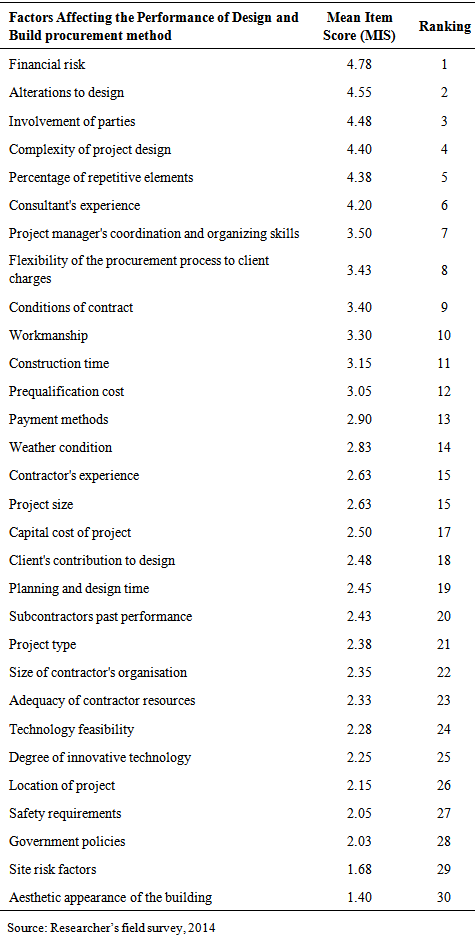 |
| |
|
Table 3.3 illustrates most important factors affecting the performance of traditional procurement method in the respondents’ respective firms. It can be inferred from the table that the three most important factors affecting performance at present are complexity of project design with mean item score of 5.0, capital cost of project with mean item score of 4.83, adequacy of contractor resources with mean item score of 4.65 and construction time with mean item score of 4.60 followed by project manager's coordination and organizing skills with mean score of 4.55 and financial risk which has a mean score of 4.35. Ranking least are the site risk factors, location of project, prequalification cost, government policies and payment methods with mean item sores of 1.68, 1.58, 1.55, 1.50 and 1.28 respectively in declining order all of which fall into the “important” category. The outcome of this research was found to be consistent with the work of Waziri (2012).Table 3.4 shows that financial risk with mean item score of 4.78 ranked 1st in the list of factors that affect the performance of design & build projects while alterations to design, involvement of parties to the contract, complexity of project design and percentage of repetitive elements were ranked 2nd, 3rd, 4th and 5th respectively. Consequently, the aesthetic appearance of the building ranked the least with mean item score of 1.40, followed by the site risk factors, government policies, safety requirements and the location of project ranking 29th, 28th, 27th and 26th respectively.
3.2. Result Results and Discussion of Analysis from Secondary Data
3.2.1. Comparison of Cost and Time Performance between Traditional and Design & Build Procurement Methods
Descriptive Analysis and Results Discussion using Percentage Cost OverrunThe Bar Charts in figure 3.1 is a descriptive presentation showing the comparison of trend between the traditional and design and build methods of procurement in terms of time performance using percentage cost performance.Figure 3.1 shows the comparison of trend between the traditional and design and build methods of procurement in terms of cost performance using percentage cost overrun. It was revealed that throughout, the average percentage cost overrun for the traditional method is higher than that of the design & build method.Descriptive Analysis and Results Discussion using Percentage Time OverrunFigure 3.2 is a descriptive presentation showing the comparison of trend between the traditional and design and build methods of procurement in terms time performance using percentage time performance respectively.It was shown in Figure 3.2 shows the comparison of trend between the traditional method and the design & build method of procurement in terms of time performance using percentage time overrun and reveals that throughout the project on the average the percentage time overruns for the traditional method is higher than that of the design and build method of procurement.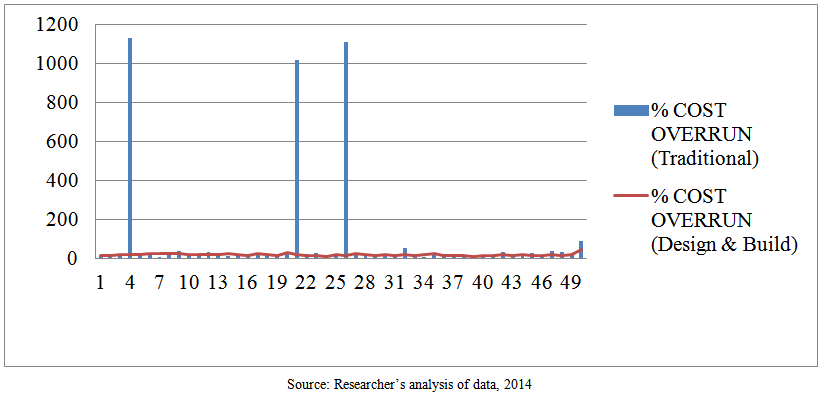 | Figure 3.1. Trend Comparison of Percentage Cost Overrun between Traditional and Design & Build Method of Procurement |
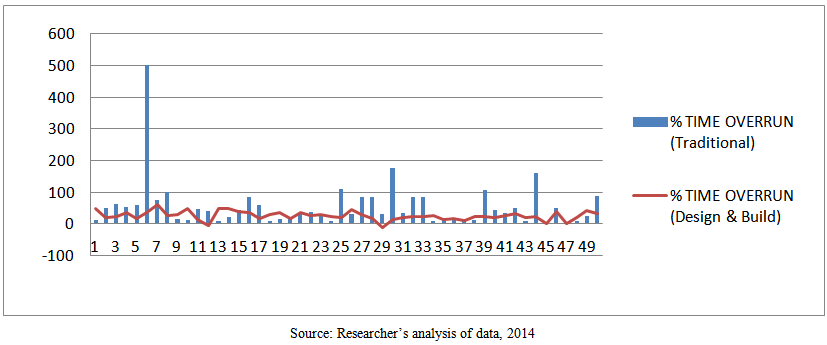 | Figure 3.2. Trend Comparison of Percentage Time Overrun between Traditional and Design & Build Method of Procurement |
3.2.2. Assessment of Cost and Time Performance using Inferential Statistics
The type of inferential analysis used for the study of Cost and Time performance between the Traditional and Design & Build procurement methods for fifty selected projects was the T – Test to determine the statistical difference existing between the traditional and design and build methods of procurement. Data used for the inferential analysis are presented in Tables 3.5 and 3.6 below:Table 3.5. Secondary Data on Cost Overrun for Design & Build and Traditional Procurement Methods
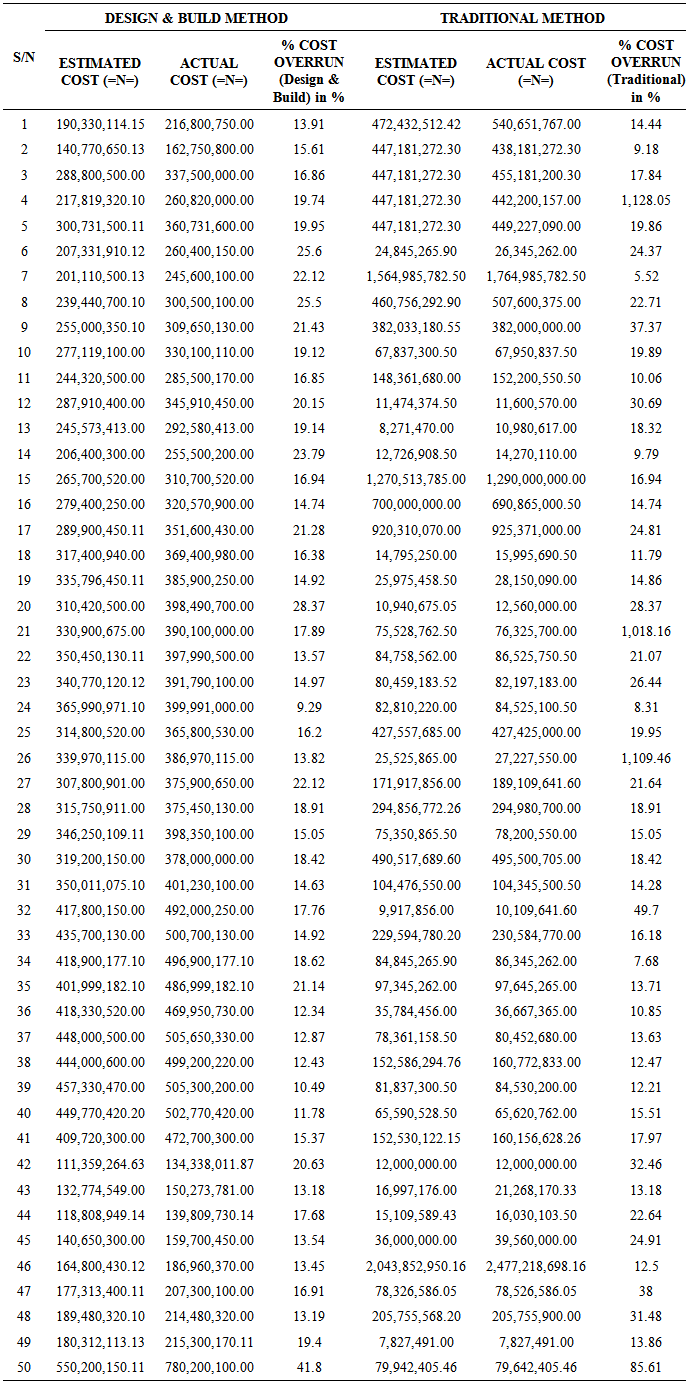 |
| |
|
Table 3.6. Secondary Data on Time Overrun for Design & Build and Traditional Procurement Methods
 |
| |
|
Table 3.5 above contains information on the estimated and actual cost of the 50 projects selected in Naira (=N=) for both Design & Build and Traditional procurement methods. The percentage cost overrun was also computed from the information gathered and also shown in the table above. The percentage cost overrun was compared between the Design & Build and Traditional procurement methods in the T- test presented and discussed later in this section. Table 3.6 above contains information on the estimated and actual time (in Months) of the 50 projects selected for both Design & Build and Traditional procurement methods. The percentage time overrun was also computed from the information gathered and also shown in the table above. The percentage time overrun was compared between the Design & Build and Traditional procurement methods in the T- test which was also presented and discussed later in this section. Inferential Analysis and Results Discussion using Percentage Cost OverrunThe first analysis was a T - test carried out to compare cost performance between the traditional and design and build methods of procurement using cost overrun. It was observed that there exists a significant difference between the traditional and design & build methods of procurement. The mean values observed for the Traditional and Design & Build Methods are 2 x 108 and 2 x 107 respectively. The observed T calculated value of 1.769 was greater than the T tabulated value of 1.658, while the observed P value of 0.001 was less than 0.005. The null hypothesis was therefore rejected. The table 3.7 shows details of the analysis.Table 3.7. Cost Performance between the Traditional and Design & Build Methods of Procurement Using Cost Overrun
 |
| |
|
The second analysis was also carried out to compare cost performance between the traditional and design and build methods of procurement using percentage cost overrun. It was also observed in this analysis that there exists a significant difference between the traditional and design & build methods of procurement. The mean values observed for the Traditional and Design & Build Methods are 84.3168 and 17.6954 respectively. The observed T calculated value of 1.769 was greater than the T tabulated value of 1.658, while the observed P value of 0.001 was less than 0.005. The null hypothesis was the also rejected in this case as shown in Table 3.8 below.Table 3.8. Cost Performance between the Traditional and Design & Build Methods of Procurement Using the Percentage Cost Overrun
 |
| |
|
Inferential Analysis and Results Discussion using Percentage Time OverrunThe third analysis was a T - test carried out to compare time performance between the traditional and design and build methods of procurement using time overrun. It was observed that there exists a significant difference between the traditional and design & build methods of procurement. The mean values observed for the Traditional and Design & Build Methods are 29.96 and 4.90 respectively. The observed T calculated value of 5.694 was greater than the T tabulated value of 1.658, while the observed P value of 0.000 was less than 0.005 as shown in Table 3.9 below. The null hypothesis was therefore rejected.Table 3.9. Time Performance between the Traditional and Design & Build Methods of Procurement Using the Time Overrun
 |
| |
|
The fourth analysis was also T - test carried out to compare time performance between the traditional and design and build methods of procurement using percentage time overrun as summarized in Table 3.10 below. It was also observed that there exists a significant difference between the traditional and design & build methods of procurement. The mean values observed for the Traditional and Design & Build Methods are 55.4614 and 25.9780 respectively. The observed T calculated value of 2.726 was greater than the T tabulated value of 1.658, while the observed P value of 0.001 was less than 0.005. The null hypothesis was therefore rejected.Table 3.10. Time Performance between the Traditional and Design & Build Methods of Procurement Using the Percentage Time Overrun
 |
| |
|
4. Conclusions
The primary goal of this research is to compare the procurement methods; design & build and the traditional method in terms of time and cost. To achieve this goal, a survey was developed and data was collected from 100 projects. Cost and time data of 50 projects were collected each for the both methods. The data was examined and the conclusion was based on the analysis of the data. The cost and overrun in which the result was found to be significant through the independent T – Test analysis in projects under both procurement methods. Certain factors affecting the performance of procurement methods were also assessed as well as criteria for the selection of suitable procurement method for project execution were also suggested in the study. Moreover, analysis of data revealed that the performance of the traditional procurement method is relatively poor compared to the design & build method in terms of cost and time overruns. The study sees to increase the level of awareness of project clients to the performance of the design and build method of procurement.
5. Recommendations
In view of the findings of this study, the following recommendations were made:a. Qualified professionals should be employed in the various construction processes to reduce the risk of time and cost overruns in the execution of projects.b. Clients adopting Design & Build procurement method for their projects should ensure that a well detailed and conclusive brief is given to the contractor before the commencement of the project. c. Since the design & build method performs better in terms of time and cost, it should therefore be encouraged by public clients.d. Factors responsible for time overruns should be tackled at early stages of project while clients should prepare sufficient analysis and be sure of their designs at the design stage. This would reduce the time for rework and variation orders.
ACKNOWLEDGEMENTS
We acknowledged the effort of Mr. Rotimi Mobolaji who helped to supply the data used in the research.
Appendix
SURVEY QUESTIONNAIREDepartment of Quantity Surveying,Federal University of Technology,P.M.B 65, Minna,Niger State,11th April, 2013.Dear Respondent,REQUEST TO COMPLETE QUESTIONAIREWe are researchers and staff of the above named institution and department presently carrying out a research on the Topic: A Comparative Analysis of Traditional and Design & Build Methods of Procurement in the Nigerian Construction Industry.This questionnaire is intended to solicit information from you or your organization so that objectives of the research will be achieved. It will be appreciated if you could provide necessary information with utmost clarity and sincerity to the best of your knowledge. The result of the research will be beneficial to contractors and other players in the construction industry.You are assured that the information provided will be used strictly for the purpose of this research and shall be treated as confidential.Thank you for your anticipated co-operation.Yours Faithfully,Researchers.Department of Quantity Surveying,School of Environmental Technology,Federal University of Technology, Minna,Niger State.QUESTIONNAIRE SURVEYA COMPARATIVE ANALYSIS OF TRADITIONAL AND DESIGN & BUILD METHODS OF PROCUREMENT IN THE NIGERIAN CONSTRUCTION INDUSTRY BACKGROUND INFORMATION SECTION BThe table below gives a list of the identified factors affecting the choice of procurement method in the Nigerian construction industry. Please kindly rank these factors for both the Traditional and Design and Build procurement methods factors in order of importance by ticking the appropriate option from the options ranked 1 – 5.
SECTION BThe table below gives a list of the identified factors affecting the choice of procurement method in the Nigerian construction industry. Please kindly rank these factors for both the Traditional and Design and Build procurement methods factors in order of importance by ticking the appropriate option from the options ranked 1 – 5.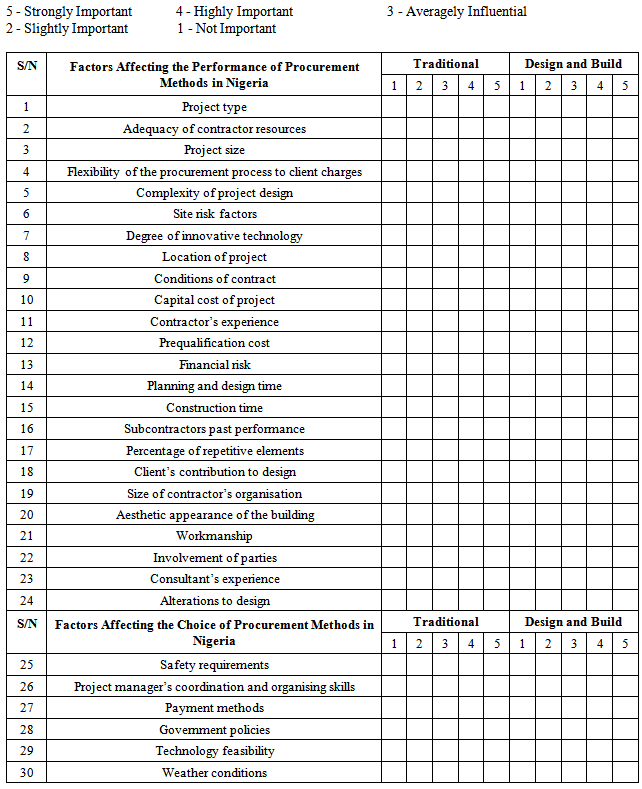 SECTION CThe table below gives a list of the identified criteria for the selection of procurement method prior to contract award from the literature review of this study. Please kindly rank these criteria in order of importance by ticking the appropriate option from the options ranked 1 – 5.
SECTION CThe table below gives a list of the identified criteria for the selection of procurement method prior to contract award from the literature review of this study. Please kindly rank these criteria in order of importance by ticking the appropriate option from the options ranked 1 – 5.
References
| [1] | Babatunde, S. O., Opawole, A. and Ujaddugbe, I. C. (2010). An Appraisal of Project Methods in the Nigerian Construction Industry. Civil Engineering Dimension, 72(1), 1-7. |
| [2] | Dada, M.O. (2012). A second look: Stakeholders' Perceptions of some issues in Design - Bid-Build Procurement Practice in Nigeria. Journal of Sustainable Development 5(T), 55-63. |
| [3] | Federal Capital Territory Administration (2014). The Administrative Map of Abuja. Federal Republic of Nigeria. Abuja. |
| [4] | Ibiyemi, A.O., Adenuga, A.O. and Odusami, K.T. (2008). Comparative Analysis of Design and Build and The Traditional Procurement methods in Lagos, Nigeria. Journal of Construction 2(2), 2-6. |
| [5] | Ogunsanmi, O.E.; lyagba, R.O.A and Omirin, MM. (2003). A Comparative study of the Performance of Traditional and Labour-Only Procurement in Nigeria. Journal of the Nigeria Institute of Building 12-27. |
| [6] | Ojo, S.O; Adeyemi, A.Y and Fagbenle, O.I (2006). The Performance of Traditional Contract Procurement on Housing Projects in Nigeria, Civil Engineering Dimension, 8 (2), 81-86. |
| [7] | Waziri, B S (2012) Modelling the performance of traditional contract projects in Nigeria: An artificial neural network approach In: Laryea, S., Agyepong, S.A., Leiringer, R. and Hughes, W. (Eds) Procs 4th West Africa Built Environment Research (WABER) Conference, 24-26 July 2012, Abuja, Nigeria, 1383-1391. |



 SECTION BThe table below gives a list of the identified factors affecting the choice of procurement method in the Nigerian construction industry. Please kindly rank these factors for both the Traditional and Design and Build procurement methods factors in order of importance by ticking the appropriate option from the options ranked 1 – 5.
SECTION BThe table below gives a list of the identified factors affecting the choice of procurement method in the Nigerian construction industry. Please kindly rank these factors for both the Traditional and Design and Build procurement methods factors in order of importance by ticking the appropriate option from the options ranked 1 – 5. SECTION CThe table below gives a list of the identified criteria for the selection of procurement method prior to contract award from the literature review of this study. Please kindly rank these criteria in order of importance by ticking the appropriate option from the options ranked 1 – 5.
SECTION CThe table below gives a list of the identified criteria for the selection of procurement method prior to contract award from the literature review of this study. Please kindly rank these criteria in order of importance by ticking the appropriate option from the options ranked 1 – 5.
 Abstract
Abstract Reference
Reference Full-Text PDF
Full-Text PDF Full-text HTML
Full-text HTML








